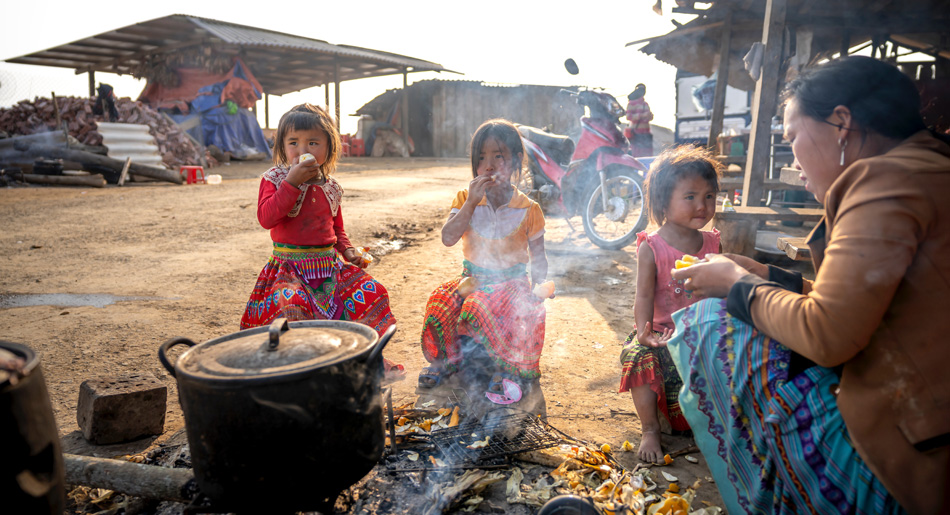Women and girls are key to food production and water collection in most parts of the world, so “women’s well-being, education, and control of household budgets is the single largest determinant of whether communities suffer from lack of access to food”.
– Kavita Ramdas
Women’s empowerment and food security are mostly talked about in isolation. We often overlook the fact that they are inextricably linked. Well, to begin with, what does food security entail? According to FAO (2001a), food security is a situation that exists when all people, at all times, have physical, social, and economic access to sufficient, safe, and nutritious food that meets their dietary needs and food preferences for an active and healthy life. Nutritional security depends on the availability of nonfood resources such as childcare, health care, clean water, and sanitation. Women play significant, if not dominant, roles in supplying the factors necessary to achieve food security in developing countries. However, women who play these roles often face social, cultural, and economic constraints. Empowering these women is the way to conquer the constraints they face. Empowerment is relatively harder to define but we will define it as the ‘ability to make strategic choices and exercise agency’ (Kabeer, 2005). The effects of being disempowered are overarching. They may lose out on education and employment opportunities which in turn curtails their economic autonomy. Their lack of economic independence also limits the say they have in important household decisions. Weak bargaining power due to the aforementioned constraints often traps them in unfavorable situations, which range from life threatening issues such as abuse, domestic violence, or daily problems like differential treatment and pro-male caregiving practices. This discrimination faced by women has direct impacts as well as acts as a hindrance to their productive activities. Their caregiving and household responsibilities act as a barrier to them pursuing employment opportunities. This forms a vicious cycle of systematic disadvantage and discrimination leading to poor economic and social outcomes for women.


Female empowerment has serious implications for food security and household welfare. Women’s incomes are more strongly associated with improvements in children’s nutritional status. Various maternal factors such as mother’s pre-pregnancy weight and nutritional status have been shown to be significant determinants of birth weight. Women’s education has been found to be correlated with the prevalence of childhood stunting (see image). Several studies have found that increases in women’s education and improvements in women’s status have significantly contributed to the reduction in the rate of child malnutrition and an overall improvement in household food security. For instance, Heckert et.al (2019) tested the hypothesis that empowering women can improve child nutrition outcomes using data from a randomized controlled trial of a nutrition-sensitive agricultural program in Burkina Faso. They examined whether four domains of women’s empowerment- purchasing decisions, healthcare decisions, family planning decisions, and spousal communication had an impact on increasing hemoglobin and reducing wasting among children. They found that improvements in women’s empowerment contributed to the program’s impact on reducing wasting with the largest share being attributable to spousal communication.
Another study by Kabir (2020) used nationally representative data from the Bangladesh Demographic Health Survey to investigate the association of women’s empowerment with maternal undernutrition and low birth weight. They used a women’s empowerment index which was constructed using principal component analysis with five groups of indicators: education, access to socio-familial decision making, economic contribution and access to economic decision making, attitudes towards domestic violence, and mobility. The women’s empowerment index was significantly associated with both maternal undernutrition and low birth weight. Galiè (2019) presents a mixed-methods study that examines the relationship between women’s empowerment, household food security, and maternal and child diet diversity (an indicator of nutrition security) in Tanzania. They used three empowerment domains: income, assets, and time use. They found that all three empowerment domains were positively associated with food security and nutrition in the qualitative analysis. The quantitative component, however, showed no correlation between women’s overall empowerment and household food security. The discrepancies are partially explained by different domains and definitions used in qualitative and quantitative methods. Further, they can be interpreted as ‘aspirational’ versus ‘actual’ empowerment–nutrition correlations. Typical gender roles dictate that men are primarily responsible for food security and women for ensuring nutritional security. The caveat is that women need to have a say in the household’s food security decisions to be able to fulfill their responsibility of providing nutritional security. Structural inequalities, however, limit the participation of women and girls in decision-making roles and deny them control over important economic resources, such as land and livestock.
Women’s ability to fulfill their roles as food producers can be enhanced by improving women’s access to resources, technology, and information. Investing in women’s human capital through education and training and removing barriers to the productive use of women’s time and energy are key to sustainable and gender-sensitive food policy. Often men migrate in search of work which puts women in a tricky spot as they have to fulfill the responsibilities of the head of household without the same rights to own property and resources that men have. Empowering women by strengthening their control over a range of assets is critical for enhancing their welfare as well as improving the status of future generations. These disparities owing to the legal framework around property rights systems that are biased against women which indicates a need to change laws. In conclusion, Lisa Palmer sums up my thoughts perfectly, “There is a real need for breakthroughs about how these complex social and environmental problems can be tackled, and I believe they can be tackled together”.
References
Alessandra Galiè et. al. Women’s empowerment, food security and nutrition of pastoral communities in Tanzania, Global Food Security, Volume 23, 2019.
Jessica Heckert et. al. Is women’s empowerment a pathway to improving child nutrition outcomes in a nutrition-sensitive agriculture program? Evidence from a randomized controlled trial in Burkina Faso, Social Science & Medicine, 2019.
Kabir, Alamgir et al. “Women’s empowerment is associated with maternal nutrition and low birth weight: evidence from Bangladesh Demographic Health Survey.” BMC women’s health vol. 20,1 93. 5 May. 2020.
Kabeer, N., 2005. Gender equality and women’s empowerment: a critical analysis of the third millennium development goal 1. Gender. Dev.
Mbow, C., et al, 2019: Food Security in Climate Change and Land: an IPCC special report on climate change, desertification, land degradation, sustainable land management, food security, and greenhouse gas fluxes.
Turner, J. 2012. Gender Equality and the MDGs in Asia and the Pacific. Gender Network News. Manila.
Quisumbing et.al, 2001. Empowering women to achieve food security. International Food Policy Research Institute. Washington D.C.
About the writer:
Ipsita Chatterjee is a Student Ambassador under CSR India’s project in collaboration with Twitter India, “Digital Citizenship & Civic Participation for Gender Equality”. She is currently pursuing her Post Graduate Diploma in Advanced Studies and Research in Economics from Ashoka University.





